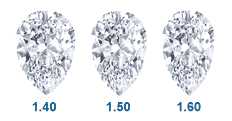Contact
Click below to speak to a Diamond Consultant or customer service.
or
Live Chat8:00 am - 6:00 pm CST (Mon - Fri)

Click below to speak to a Diamond Consultant or customer service.
or
Live Chat8:00 am - 6:00 pm CST (Mon - Fri)

The modified brilliant-cut pear shaped diamond is a combination of a round and a marquise shape, with a tapered point on one end. The diamond is always worn with the narrow end pointing toward the hand of the wearer. Like marquise and oval cuts, the pear shaped diamond comes in a variety of slim to wide cuts, and has the added benefit of making the wearer's fingers appear longer and slimmer.
Ideally, a pear shaped diamond should possess excellent or very good symmetry. The point should line up with the apex of the rounded end. The shoulders and wings (the upper and lower curves on the right and left side of the diamond) should form uniform, symmetrical curves, with no straight edges. The rounded top should not appear narrow or squat, but like a semi-circle. In a misguided effort to add weight to a diamond (by incorporating more of the rough stone in the final cut) cutters may give the diamond added girth near the point or top, giving the diamond a squared off or squatty appearance.

While the length to width ratio of classic pear shaped diamonds is 1.40-1.70, personal preference will again dictate choice. The shape preference may also be affected by the diamond's eventual setting: A narrow pear diamond is ideal for dangle earrings, while a wider shape might be preferred for a solitaire ring. Every Lumera Diamond includes precise measurements, as well as the length to width ratio, so you know the exact shape of the pear shaped diamond you are considering.
Pear shaped diamonds posses some degree of bow-tie, varying from near invisible to severe. The visibility of a bow-tie effect cannot be ascertained by reviewing the diamond certificate or dimensions, but only upon visual inspection. If you are interested in purchasing a pear cut diamond, but would like to have it inspected first, please contact a diamond consultant, who can review diamonds on your behalf. chat online, or email [email protected].
A pear diamond should always be set with a prong at the point - the most likely location for chipping on a pear cut diamond. Because this point was once nearest the outer edge of the rough stone, flaws such as naturals, extra facets, and other inclusions may be located here. Since the point is covered by a prong, these flaws will be invisible once the diamond is set. The only remaining concern would be if the flaws are significant enough to affect the stability of the diamond (this is extremely rare, however).
The chart below serves as a general guideline for evaluating the cut of a pear shaped diamond.
| EXCELLENT | VERY GOOD | GOOD | FAIR | POOR | |
|---|---|---|---|---|---|
| Table % | 53 - 63 |
52
or 64 - 65 |
51
or 66 - 68 |
50
or 69 - 70 |
< 50
or > 70 |
| Depth % | 58 - 62 |
56 - 57.9
or 62.1 - 66 |
53 - 55.9
or 66.1 - 71 |
50 - 52.9
or 71.1 - 74 |
< 50
or > 74 |
| Girdle | Very Thin - Slightly Thick |
Very Thin
to Thick |
Very Thin
to Very Thick |
Ex. Thin
to Ex. Thick |
|
| Culet | None | Very Small | Small | Medium | > Medium |
| L/W Ratio | 1.45 - 1.55 |
1.40 - 1.44
or 1.56 - 1.65 |
1.35 - 1.39
or 1.66 - 1.80 |
1.25 - 1.34
or 1.81 - 2.00 |
> 1.25
or < 2.00 |
Evaluating color in pear diamonds is subjective. Keep in mind that many buyers may actually prefer the ever so slightly warmer colors of a G-H diamond over the cool colorlessness of a D-F diamond. In fact, most of the premium in price associated with pear shaped diamonds at the higher end of the color scale is driven by supply and demand; customers want the D-F color grades, and are willing to pay a premium to get them. In a world without diamond color grading, the price premium for higher grades would be much lower, as the actual differences in color are difficult to perceive.
In larger pear diamonds (over 1 carat), the color may appear slightly darker at the point. For this reason, buyers may choose to move up one color grade as compared to other diamond shapes. The color chart below provides a general guide for evaluating color in pear shaped diamonds.
| EXCELLENT | VERY GOOD | GOOD | FAIR | POOR | |
|---|---|---|---|---|---|
| < .50 ct. | D - G | H - I | J - K | L - M | > M |
| .51-1.0 ct. | D - F | G | H - I | J - K | > K |
| 1.0-2.0 ct. | D - F | G - H | I - J | > J | |
| > 2.0 ct. | D - F | G | H - I | > I | |
| Fluoro | None | Faint - Med | Strong | Very Strong | |
Like color, evaluating clarity in pear diamonds is subjective. GIA provides excellent help with their clarity grades. Still, it is important to understand that each customer will have a unique standard for clarity. Some may be perfectly comfortable with an inclusion as long as they cannot easily see it. Others may insist on a more technically flawless appearance. The clarity chart below provides a general guide for evaluating clarity in pear shaped diamonds.
| EXCELLENT | VERY GOOD | GOOD | FAIR | POOR | |
|---|---|---|---|---|---|
| < .50 ct. | FL - VS2 | SI1 - SI2 | I1 | I2 | > I2 |
| .51-1.0 ct. | FL - VS1 | VS2 - SI1 | SI2 | I1 - I2 | > I2 |
| 1.0-2.0 ct. | FL - VVS2 | VS1 - VS2 | SI1 - SI2 | I1 | > I1 |
| > 2.0 ct. | FL - VVS2 | VS1 - VS2 | SI1 | SI2 | > SI2 |
Questions about shape or other aspects of a diamond? Ask a diamond consultant for answers. A consultant will answer any questions you have, and if you like, search for diamonds on your behalf that match your criteria. chat online, or email [email protected].

